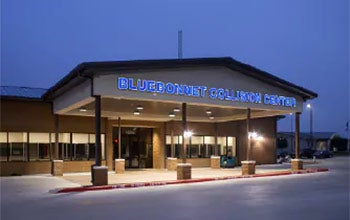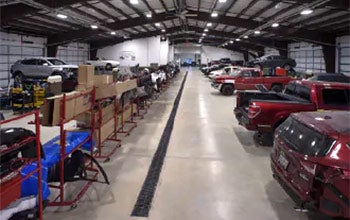FAQ and Glossary
FAQ and Glossary
New Braunfels, TX
FAQ's
No. In the end, the choice is yours. Bluebonnet Collision Center has direct repair contracts with many major insurance companies. We do not have to be on your insurance company's direct repair list in order to repair your car. Bluebonnet works with all insurance companies, and maintains good business relationships with all of their local adjusters, making it easy to complete your repairs and your paperwork.
No. You only need to get one estimate at the shop of your choice.
If the insurance company has already written an estimate, it is a good starting point for us. The estimate has useful information such as the claim number, a parts list, and the adjuster's contact information. However, many times the insurance company will write an estimate that is conservative, and will wait until your car is at the Bluebonnet Collision Center and taken apart. Often times, there is hidden damage that cannot be seen until it is dismantled. That is when we contact them to report additional damage and costs.
Hold on to the check until after your car repairs are finished, and bring it with you when you are picking up your car.
In general, car manufacturers do not sell paint. The Bluebonnet Collision Center refinishes cars using a PPG High Performance Envirobase waterborne paint system, restoring your car's finish to its original condition. Our paint system is environmentally friendly, reducing the amount of VOCs that are emitted. And it is warranted by the manufacturer for as long as you have your car.
The Bluebonnet Collision Center uses multiple different methods to match paint. Your car's color code is located on the car. Our painters will input it into their computer, and the computer provides the formula for mixing it. We also employ a spectrophotometer to help match your car's color. Lastly, we tone in our colors by spraying test panels, ensuring that the color matches before we apply it to your car.
The Bluebonnet Collision Center would like to use all factory parts for your repairs. However, it's the insurance policy that dictates what types of parts will be used. If the policy states that alternative parts are to be used when they are available, that is how the estimate is prepared. However, you do have the option of requesting that genuine factory parts be installed and paying the price difference.
The time that the Bluebonnet Collision Center has your car depends on the extent of damage, and whether or not hidden damage is found once your car is taken apart. To minimize delays, parts are ordered per the preliminary estimate, and received before your car arrives. We also keep in touch throughout the claims process, to let you know how repairs are going and when we think they will be complete.
The Bluebonnet Collision Center works on all makes and models of cars, sport utilities, and trucks. We are experienced at repairing all makes and models. All of our technicians are i-Car and ASE certified and attend continuing education classes for the most up-to-date methods and technology advancements.
Yes. . When you are dropping your car for repair, we can call a rental company for you. They will pick you up and shuttle you to their location to pick a car and go over the contract with you.
That depends. If you are using your insurance company to have your car repaired, your rental will be paid for, or partially paid for if you purchased rental car coverage with your policy. Your insurance company claim's department can go over details with you. If you are using the other party's insurance company to have your car repaired, a rental car can be provided while your car is at the Bluebonnet Collision Center. Again, ask your claims adjuster for details.
Glossary Of Abbreviations and Terms
Direct Repair Programs (DRP) or insurance company referrals of certain repair facilities could be known as: State Farm's "Service First" program, Allstate's "PRO" program, USAA's "STARS" program, Progressive's "Total Pro or Concierge" program, and Nationwide's "Blue Ribbon" program. Please refer to our glossary of other known insurance company DRF or referral program names.
Although insurance companies refer to direct repair programs differently, they essentially mean the same thing. DRP repair facilities are shops that have formed strategic alliances with insurers. The shop meets the insurance company's criteria of their specific program and the shop agrees to do business in that manner. The insurance company's purpose of DRP (Direct Repair Programs) is to streamline the claims settlement process and they work closely with a select repair facility to accomplish that. The shop agrees to provide many of the administrative duties of the insurance carrier in exchange for the referral.
We will still explain the repair process to you, the vehicle owner. It should be understood and agreed upon on what is being repaired vs. what is being replaced, and what type parts are being utilized in the repair process prior to the vehicle owner authorizing us to proceed with the vehicle repairs. It is the consumer's responsibility and right to choose the repair facility of their choice and authorize the repairs based on a thorough and agreed upon damage evaluation. DRP's (Direct Repair Programs) are an optional program of the insurance carrier. The consumer is not required or obligated to use a DRP repair facility.
The abbreviation "OEM" implies that the part or parts are made by the original car company manufacturer or its licensed supplier and is a genuine new part with vehicle manufacturer warranty.
This abbreviation for "aftermarket" indicates parts made by a manufacturer other than the original vehicle manufacturer. These parts are warranted by the manufacturer of the part or their distributor. There are two levels of aftermarket parts; "certified" and "not certified".
Quality Replacement Part, another term for Aftermarket Parts.
Another term for Aftermarket Parts.
Like, Kind and Quality. Used parts from a salvage vehicle of the same make and model, usually from the same year or newer than the vehicle being repaired with comparable or less mileage than the vehicle it is being used for.
Used parts from a salvage vehicle that re-enters commerce when sold to a repair shop. The repairer then takes the used component and performs the necessary steps to put it in a recycled condition that will then be utilized in the repair process.
A used, original factory part that has been refurbished to new condition. This could be an original car company (OEM) part or an aftermarket supplier. This procedure could be performed by an original car company supplier or a licensed aftermarket supplier for the car company.
A rebuilt part may not be an original car company part; it could be an aftermarket supplied part. This is a part that is being repaired and serviced for the purpose of resale. Rebuilt parts are typically supplied by an aftermarket source.
This abbreviation is for "Certified Automotive Parts Association" - CAPA parts are aftermarket parts certified by an unbiased third party that insures the quality of the parts they test are equal to or greater than the original car company part.
Overhaul - Remove an assembly, disassemble, clean and visually inspect it, replace needed parts, reassemble and reinstall on the vehicle making any necessary adjustments.
Remove and Install. Usually referring to parts being removed from a vehicle to facilitate repairs or to allow access. The same part is then reinstalled on the same vehicle it was removed from.
Remove and Replace. This abbreviation means that a part is being removed and replaced with a new, recycled or aftermarket part.
A process of gradually blending the paint into the adjacent panel being replaced or repaired to facilitate an acceptable color match.
Means time spent by a painter to tint the color to achieve an acceptable paint match.
A product put in paint to make the paint flexible for use on soft parts, such as bumper covers and side moldings.
Process of sanding a repainted surface with ultra fine sandpaper to remove minor surface imperfections in the paint, or to achieve the same texture of the paint finish as the rest of the vehicle. After sanding the repainted parts are then buffed to restore original gloss. This process may also be referred to as ""Final Sand and Buff" or "Finessing".
Paintless Dent Repair The process using specialty tools to remove minor, rounded dents, such as hail damage dents, without damaging the paint.




